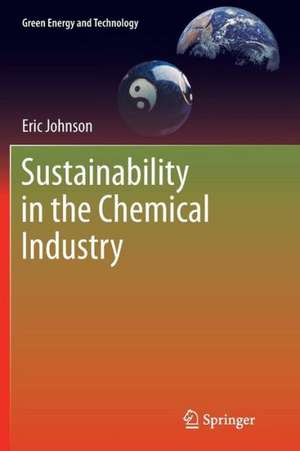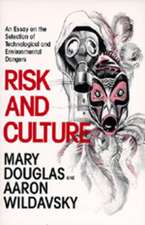Sustainability in the Chemical Industry: Green Energy and Technology
Autor Eric Johnsonen Limba Engleză Paperback – 9 mai 2014
Sustainability describes a change in the chemical industry’s approach to the external world: to regulators, to greens, to neighbors, to investors and to the general public. Displacing the adversarialism of the 1970s-80s, sustainability is a new approach to social/political conflict, and an attempt to rebuild the industry’s long-suffering public image. In practice, it consists of:
A ‘stakeholder’ approach to communications and external relations
A rebranding of regulatory compliance and risk management, with the emphasis on their benefits to stakeholders
Recognition (and even celebration) of the opportunities, not just the costs, of environmental and social protection
The core of this book is a survey of the world’s 29 largest chemical companies: how they put sustainability into action (six of the 29 do not), and the six ‘sustainability brands’ they have created. It begins with a history of stakeholders conflict, before looking at various definitions of sustainability – by academics, by the public and by investors. After the survey and analysis, the book covers sustainability and ‘greenwash’ plus the ROI of sustainability, and it gives five recommendations.
| Toate formatele și edițiile | Preț | Express |
|---|---|---|
| Paperback (1) | 635.31 lei 43-57 zile | |
| SPRINGER NETHERLANDS – 9 mai 2014 | 635.31 lei 43-57 zile | |
| Hardback (1) | 641.53 lei 43-57 zile | |
| SPRINGER NETHERLANDS – 18 apr 2012 | 641.53 lei 43-57 zile |
Din seria Green Energy and Technology
- 18%
 Preț: 943.43 lei
Preț: 943.43 lei - 20%
 Preț: 629.52 lei
Preț: 629.52 lei - 18%
 Preț: 1124.92 lei
Preț: 1124.92 lei - 18%
 Preț: 947.35 lei
Preț: 947.35 lei - 15%
 Preț: 655.92 lei
Preț: 655.92 lei - 18%
 Preț: 957.62 lei
Preț: 957.62 lei - 18%
 Preț: 789.52 lei
Preț: 789.52 lei - 17%
 Preț: 464.55 lei
Preț: 464.55 lei - 15%
 Preț: 645.79 lei
Preț: 645.79 lei - 18%
 Preț: 903.93 lei
Preț: 903.93 lei - 24%
 Preț: 1322.07 lei
Preț: 1322.07 lei - 18%
 Preț: 890.54 lei
Preț: 890.54 lei - 18%
 Preț: 1115.46 lei
Preț: 1115.46 lei - 18%
 Preț: 1117.03 lei
Preț: 1117.03 lei - 18%
 Preț: 949.73 lei
Preț: 949.73 lei - 18%
 Preț: 892.11 lei
Preț: 892.11 lei - 15%
 Preț: 648.24 lei
Preț: 648.24 lei - 18%
 Preț: 997.09 lei
Preț: 997.09 lei - 15%
 Preț: 579.81 lei
Preț: 579.81 lei - 18%
 Preț: 1123.15 lei
Preț: 1123.15 lei - 18%
 Preț: 961.41 lei
Preț: 961.41 lei - 17%
 Preț: 490.22 lei
Preț: 490.22 lei - 18%
 Preț: 904.60 lei
Preț: 904.60 lei - 15%
 Preț: 643.34 lei
Preț: 643.34 lei -
 Preț: 287.90 lei
Preț: 287.90 lei - 24%
 Preț: 634.04 lei
Preț: 634.04 lei -
 Preț: 379.39 lei
Preț: 379.39 lei - 18%
 Preț: 783.20 lei
Preț: 783.20 lei - 18%
 Preț: 1394.84 lei
Preț: 1394.84 lei - 18%
 Preț: 1691.57 lei
Preț: 1691.57 lei - 18%
 Preț: 1112.48 lei
Preț: 1112.48 lei - 15%
 Preț: 592.61 lei
Preț: 592.61 lei - 18%
 Preț: 952.09 lei
Preț: 952.09 lei - 18%
 Preț: 944.19 lei
Preț: 944.19 lei - 18%
 Preț: 891.33 lei
Preț: 891.33 lei - 18%
 Preț: 1252.44 lei
Preț: 1252.44 lei - 18%
 Preț: 789.52 lei
Preț: 789.52 lei - 20%
 Preț: 566.29 lei
Preț: 566.29 lei - 18%
 Preț: 1113.71 lei
Preț: 1113.71 lei - 18%
 Preț: 1114.24 lei
Preț: 1114.24 lei - 24%
 Preț: 590.58 lei
Preț: 590.58 lei - 20%
 Preț: 567.49 lei
Preț: 567.49 lei - 24%
 Preț: 907.48 lei
Preț: 907.48 lei - 18%
 Preț: 952.89 lei
Preț: 952.89 lei - 18%
 Preț: 952.89 lei
Preț: 952.89 lei - 18%
 Preț: 950.52 lei
Preț: 950.52 lei
Preț: 635.31 lei
Preț vechi: 747.43 lei
-15% Nou
Puncte Express: 953
Preț estimativ în valută:
121.56€ • 127.27$ • 100.59£
121.56€ • 127.27$ • 100.59£
Carte tipărită la comandă
Livrare economică 07-21 aprilie
Preluare comenzi: 021 569.72.76
Specificații
ISBN-13: 9789401781558
ISBN-10: 9401781559
Pagini: 192
Ilustrații: XVI, 176 p.
Dimensiuni: 155 x 235 x 10 mm
Greutate: 0.28 kg
Ediția:2012
Editura: SPRINGER NETHERLANDS
Colecția Springer
Seria Green Energy and Technology
Locul publicării:Dordrecht, Netherlands
ISBN-10: 9401781559
Pagini: 192
Ilustrații: XVI, 176 p.
Dimensiuni: 155 x 235 x 10 mm
Greutate: 0.28 kg
Ediția:2012
Editura: SPRINGER NETHERLANDS
Colecția Springer
Seria Green Energy and Technology
Locul publicării:Dordrecht, Netherlands
Public țintă
ResearchCuprins
1 Abstract.- 2 Foreword: Why This Book?- 3 Summary: Sustainability Is Advancing, With More Changes To Come.- 4 Introduction: Sustainability’s Bandwagon Has Left The Station, But Where Is It Headed?- 5 Why The Chemical Industry Turned To Sustainability.- 6 How Others Define Sustainability.- 7 How Chemical Companies Define Sustainability, In Practice.- 8 Sustainability ‘Brands’.- 9 The Thin Green Line: Between Sustainability And Greenwash.- 10 Evaluating Sustainability: Is It Necessary, And Does It Pay?- 11 Is There A Non-Sustainable Option?- 12 Get On Sustainability’s Bandwagon, But Not Blindly Or Blithely.- 13 Appendix 1: Company Classification.- 14 Appendix 2: Quantity Versus Quality – How Experts And Laypeople Disagree About Technology Risks.- 15 References.
Notă biografică
Eric Johnson, a chemist, has for most of his career worked in and around the chemical and energy industries. He is Managing Director of Atlantic Consulting, Editor-in-Chief of Environmental Impact Assessment Review, a Director of the NGO Green Cross and a Technical Advisor to the Blacksmith Institute. Formerly he was an editor at Chemical Engineering and Chemical Week, a correspondent for McGraw-Hill World News and a bureau manager for what is now Thompson Reuters.
Textul de pe ultima copertă
It’s the new rock and roll. It’s the new black. Sustainability is trendy, and not just among hipsters and pop stars. The uncool chemical sector helped pioneer it, and today, companies inside and outside the sector have embraced it. But what have they embraced? Surely not the Brundtland definition of meeting “the needs of the present without compromising the ability of future generations to meet their own needs.”
Sustainability describes a change in the chemical industry’s approach to the external world: to regulators, to greens, to neighbors, to investors and to the general public. Displacing the adversarialism of the 1970s-80s, sustainability is a new approach to social/political conflict, and an attempt to rebuild the industry’s long-suffering public image. In practice, it consists of:
A ‘stakeholder’ approach to communications and external relations
A rebranding of regulatory compliance and risk management, with the emphasis on their benefits to stakeholders
Recognition (and even celebration) of the opportunities, not just the costs, of environmental and social protection
The core of this book is a survey of the world’s 29 largest chemical companies: how they put sustainability into action (six of the 29 do not), and the six ‘sustainability brands’ they have created. It begins with a history of stakeholders conflict, before looking at various definitions of sustainability – by academics, by the public and by investors. After the survey and analysis, the book covers sustainability and ‘greenwash’ plus the ROI of sustainability, and it gives five recommendations.
Sustainability describes a change in the chemical industry’s approach to the external world: to regulators, to greens, to neighbors, to investors and to the general public. Displacing the adversarialism of the 1970s-80s, sustainability is a new approach to social/political conflict, and an attempt to rebuild the industry’s long-suffering public image. In practice, it consists of:
A ‘stakeholder’ approach to communications and external relations
A rebranding of regulatory compliance and risk management, with the emphasis on their benefits to stakeholders
Recognition (and even celebration) of the opportunities, not just the costs, of environmental and social protection
The core of this book is a survey of the world’s 29 largest chemical companies: how they put sustainability into action (six of the 29 do not), and the six ‘sustainability brands’ they have created. It begins with a history of stakeholders conflict, before looking at various definitions of sustainability – by academics, by the public and by investors. After the survey and analysis, the book covers sustainability and ‘greenwash’ plus the ROI of sustainability, and it gives five recommendations.
Caracteristici
A survey of the world’s largest chemical companies is at the core of this book. It is an empirical examination of sustainability practice Practice is outlined in detail in a series of table that show, and compare, what these leading companies are doing (and not doing) in sustainability Explanation of the diverse definitions of sustainability held by academics, the public and investors








